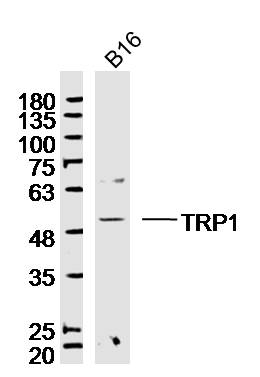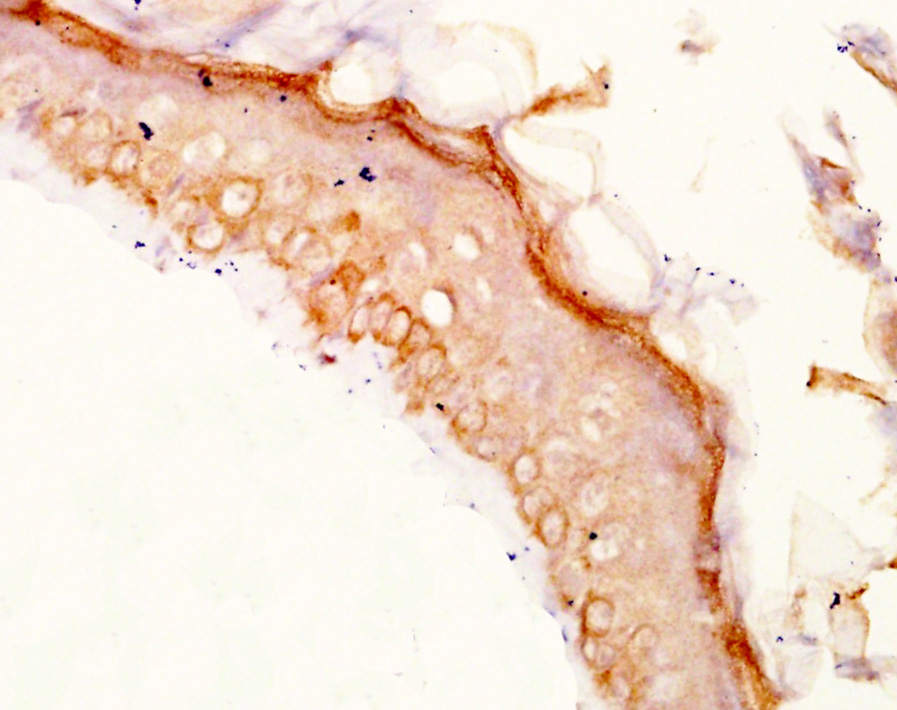TYRP1 Rabbit pAb
TYRP1 Rabbit pAb
- 产品详情
- 实验流程
- 背景知识
Application
| WB, IHC-P, IHC-F, IF |
|---|---|
| Primary Accession | P17643 |
| Reactivity | Human |
| Host | Rabbit |
| Clonality | Polyclonal |
| Calculated MW | 60724 Da |
| Physical State | Liquid |
| Immunogen | KLH conjugated synthetic peptide derived from human TYRP1 |
| Epitope Specificity | 101-200/537 |
| Isotype | IgG |
| Purity | affinity purified by Protein A |
| Buffer | 0.01M TBS (pH7.4) with 1% BSA, 0.02% Proclin300 and 50% Glycerol. |
| SUBCELLULAR LOCATION | Melanosome membrane; Single-pass type I membrane protein (By similarity). Note=Located to mature stage III and IV melanosomes and apposed endosomal tubular membranes. Transported to pigmented melanosomes by the BLOC-1 complex (By similarity). |
| SIMILARITY | Belongs to the tyrosinase family. |
| DISEASE | Albinism oculocutaneous 3 (OCA3) [MIM:203290]: An autosomal recessive disorder in which the biosynthesis of melanin pigment is reduced in skin, hair, and eyes. Tyrosinase activity is normal and patients have only moderate reduction of pigment. The eyes present red reflex on transillumination of the iris, dilution of color of iris, nystagmus and strabismus. Darker-skinned individuals have bright copper-red coloration of the skin and hair. Note=The disease is caused by mutations affecting the gene represented in this entry. |
| Important Note | This product as supplied is intended for research use only, not for use in human, therapeutic or diagnostic applications. |
| Background Descriptions | TRP1 is a melanosomal enzyme that belongs to the tyrosinase family and plays an important role in the melanin biosynthetic pathway. Defects in this gene are the cause of rufous oculocutaneous albinism and oculocutaneous albinism type III. |
| Gene ID | 7306 |
|---|---|
| Other Names | 5, 6-dihydroxyindole-2-carboxylic acid oxidase, DHICA oxidase, 1.14.18.-, Catalase B, Glycoprotein 75, Melanoma antigen gp75, Tyrosinase-related protein 1, TRP, TRP-1, TRP1, TYRP1 (HGNC:12450) |
| Target/Specificity | Pigment cells. |
| Dilution | WB=1:500-2000,IHC-P=1:100-500,IHC-F=1:100-500,IF=1:100-500 |
| Storage | Store at -20 °C for one year. Avoid repeated freeze/thaw cycles. When reconstituted in sterile pH 7.4 0.01M PBS or diluent of antibody the antibody is stable for at least two weeks at 2-4 °C. |
| Name | TYRP1 (HGNC:12450) |
|---|---|
| Function | Plays a role in melanin biosynthesis (PubMed:16704458, PubMed:22556244, PubMed:23504663). Catalyzes the oxidation of 5,6- dihydroxyindole-2-carboxylic acid (DHICA) into indole-5,6-quinone-2- carboxylic acid in the presence of bound Cu(2+) ions, but not in the presence of Zn(2+) (PubMed:28661582). May regulate or influence the type of melanin synthesized (PubMed:16704458, PubMed:22556244). Also to a lower extent, capable of hydroxylating tyrosine and producing melanin (By similarity). |
| Cellular Location | Melanosome membrane {ECO:0000250|UniProtKB:P07147}; Single-pass type I membrane protein {ECO:0000250|UniProtKB:P07147}. Note=Located to mature stage III and IV melanosomes and apposed endosomal tubular membranes. Transported to pigmented melanosomes by the BLOC-1 complex. Proper trafficking to melanosome is regulated by SGSM2, ANKRD27, RAB9A, RAB32 and RAB38 {ECO:0000250|UniProtKB:P07147} |
| Tissue Location | Pigment cells. |
Research Areas
For Research Use Only. Not For Use In Diagnostic Procedures.
Application Protocols
Provided below are standard protocols that you may find useful for product applications.
BACKGROUND
TRP1 is a melanosomal enzyme that belongs to the tyrosinase family and plays an important role in the melanin biosynthetic pathway. Defects in this gene are the cause of rufous oculocutaneous albinism and oculocutaneous albinism type III.
终于等到您。ABCEPTA(百远生物)抗体产品。
点击下方“我要评价 ”按钮提交您的反馈信息,您的反馈和评价是我们最宝贵的财富之一,
我们将在1-3个工作日内处理您的反馈信息。
如有疑问,联系:0512-88856768 tech-china@abcepta.com.
¥ 1,500.00
Cat# AP56026























 癌症的基本特征包括细胞增殖、血管生成、迁移、凋亡逃避机制和细胞永生等。找到癌症发生过程中这些通路的关键标记物和对应的抗体用于检测至关重要。
癌症的基本特征包括细胞增殖、血管生成、迁移、凋亡逃避机制和细胞永生等。找到癌症发生过程中这些通路的关键标记物和对应的抗体用于检测至关重要。 为您推荐一个泛素化位点预测神器——泛素化分析工具,可以为您的蛋白的泛素化位点作出预测和评分。
为您推荐一个泛素化位点预测神器——泛素化分析工具,可以为您的蛋白的泛素化位点作出预测和评分。 细胞自噬受体图形绘图工具为你的蛋白的细胞受体结合位点作出预测和评分,识别结合到自噬通路中的蛋白是非常重要的,便于让我们理解自噬在正常生理、病理过程中的作用,如发育、细胞分化、神经退化性疾病、压力条件下、感染和癌症。
细胞自噬受体图形绘图工具为你的蛋白的细胞受体结合位点作出预测和评分,识别结合到自噬通路中的蛋白是非常重要的,便于让我们理解自噬在正常生理、病理过程中的作用,如发育、细胞分化、神经退化性疾病、压力条件下、感染和癌症。







